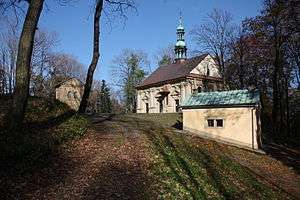Calvary (sanctuary)



Calvary is the hill in Jerusalem where, according to tradition, Jesus was crucified, or a set of religious edifices imitating it, often constructed on hills, sometimes called Sacred Mount or Sacred Mountain. These function as greatly expanded versions of the Stations of the Cross that are usual in Catholic churches, allowing the devout to follow the progress of the stages of the Passion of Christ along the Via Dolorosa in Jerusalem. Each chapel contains a large image of the scene from the Passion it commemorates, sometimes in sculpture, that may be up to life-size. This kind of shrine was especially popular in the Baroque period when the Holy Land was under Turkish rule and it was difficult to make a pilgrimage to the Mount Calvary in Jerusalem.
Calvaries were especially popular with the Franciscan and Jesuit orders, and are most common in Italy and Habsburg Central Europe. They were usually placed in parks near a church or a monastery, typically on a hill which the visitor gradually ascends. Italian ones are usually called a sacro monte ("holy mountain" or "hill"); there are a group of nine Sacri Monti of Piedmont and Lombardy that are especially notable; their dates of foundation vary between 1486 and 1712. Devotions would be most popular in Passion Week, before Easter, when large processions around the stations would be held, and mystery plays might be acted. If a calvary was established in an inhabited place, it might result in a location of a new village or town. Several villages and towns are named after such a complex.
Calvaries in the world
Austria
Czech Republic
Ethiopia
Italy
- Sacri Monti of Piedmont and Lombardy
- Sacro Monte di Varallo
- Sacred Mount Calvary of Domodossola
- San Vivaldo Monastery in Montaione
- Sacro Monte di Orta
- Sacro Monte di Varese
- Sacro Monte di Crea
- Sacro Monte di Ghiffa
- Sacro Monte di Ossuccio
- Sacro Monte di Oropa
- Sacro Monte di Belmonte
Lithuania
Poland
- Kalwaria Zebrzydowska, near Kraków
- Góra Kalwaria, near Warsaw
- Wejherowo, near Gdańsk
- Kalwaria Pacławska, near Przemyśl
- Kalwaria Panewnicka, in Katowice
- Pakość, near Inowrocław
- Góra Świętej Anny, near Opole
- Wambierzyce, near Kłodzko
Slovakia
See also
References
- Elżbieta Bilska-Wodecka, European Calvaries: Analysis of Structures, Types and Origins
- Sacri Monti: From Jerusalem to Sacred Mounts